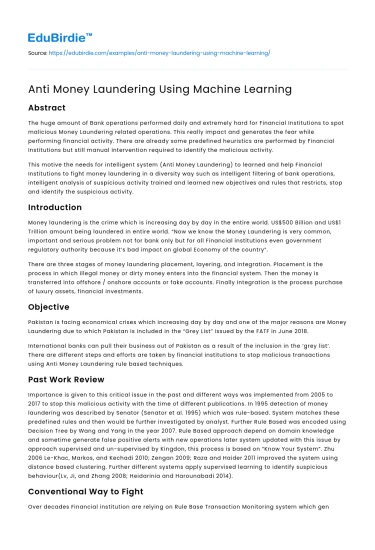Abstract
The huge amount of Bank operations performed daily and extremely hard for Financial Institutions to spot malicious Money Laundering related operations. This really impact and generates the fear while performing financial activity. There are already some predefined heuristics are performed by Financial Institutions but still manual intervention required to identify the malicious activity.
This motive the needs for intelligent system (Anti Money Laundering) to learned and help Financial Institutions to fight money laundering in a diversity way such as intelligent filtering of bank operations, intelligent analysis of suspicious activity trained and learned new objectives and rules that restricts, stop and identify the suspicious activity.
Save your time!
We can take care of your essay
- Proper editing and formatting
- Free revision, title page, and bibliography
- Flexible prices and money-back guarantee
Introduction
Money laundering is the crime which is increasing day by day in the entire world. US$500 Billion and US$1 Trillion amount being laundered in entire world. “Now we know the Money Laundering is very common, important and serious problem not for bank only but for all Financial institutions even government regulatory authority because it’s bad impact on global Economy of the country”.
There are three stages of money laundering placement, layering, and integration. Placement is the process in which illegal money or dirty money enters into the financial system. Then the money is transferred into offshore / onshore accounts or fake accounts. Finally Integration is the process purchase of luxury assets, financial investments.
Objective
Pakistan is facing economical crises which increasing day by day and one of the major reasons are Money Laundering due to which Pakistan is included in the “Grey List” issued by the FATF in June 2018.
International banks can pull their business out of Pakistan as a result of the inclusion in the ‘grey list’. There are different steps and efforts are taken by financial institutions to stop malicious transactions using Anti Money Laundering rule based techniques.
Past Work Review
Importance is given to this critical issue in the past and different ways was implemented from 2005 to 2017 to stop this malicious activity with the time of different publications. In 1995 detection of money laundering was described by Senator (Senator et al. 1995) which was rule-based. System matches these predefined rules and then would be further investigated by analyst. Further Rule Based was encoded using Decision Tree by Wang and Yang in the year 2007. Rule Based approach depend on domain knowledge and sometime generate false positive alerts with new operations later system updated with this issue by approach supervised and un-supervised by Kingdon, this process is based on “Know Your System”. Zhu 2006 Le-Khac, Markos, and Kechadi 2010; Zengan 2009; Raza and Haider 2011 improved the system using distance based clustering. Further different systems apply supervised learning to identify suspicious behaviour(Lv, Ji, and Zhang 2008; Heidarinia and Harounabadi 2014).
Conventional Way to Fight
Over decades Financial institution are relying on Rule Base Transaction Monitoring system which generate lot of false positive alerts and create lot of backlog for compliance department to review these alert transactions.
Typically, monitoring starts with a rule-based system which scans customer transactions for red flags consistent with money laundering. When a matching pattern is observed, an alert is generated and the case is referred to the bank’s internal investigation team for manual review.
Efficient Way to Fight
Using Machine Learning techniques we can complement these rule based transactions monitoring systems by substantially reducing the number of false positives alert.
Machine Learning does not perform humanistic programmed cognitive tasks. Rather, machine learning algorithms learn novel new relationships from data. Uncovering hidden patterns in money movement makes machine learning for AML a very attractive enhancement to existing AML operations.
“Clustering is used to group the account which have the suspicious transactions”.
“Techniques like Neural Network are used to detect pattern of money laundering”.
“Social Network Analysis or Link Analysis is used to find the communities involved in the money laundering”.
Discussion
In order for this to work, the modeling dataset containing historical alerts and their outcomes (SAR filed or not) must be carefully constructed from mostly the same data that is made available to reviewers.
An analyst, with little or no expertise in machine learning, can then feed the modeling dataset into the automated machine learning platform, which will perform the key steps of the model development process for them automatically.
It will determine the best ways to pre-process the data, structure it for validation and final holdout assessment, distill out the relevant features related to money laundering according to the historical data, and identify the best machine learning algorithms to apply based on this dataset. This is only the beginning of the story of how automated machine learning can be used to enhance an AML compliance program. Dataset: https://www.kaggle.com/ntnu-testimon/paysim1
Conclusion
As of 2017 Banks globally have paid $321 billion in fines since 2008 for an abundance of regulatory failings from money laundering to market manipulation and terrorist financing.
With growing amounts of data, reliance on online transactions, and the increase of digital-currency adoption, banks must address money laundering to not only stop it, but to also avoid fines. Many banks have started implementing business process automation and see Artificial Intelligence (AI )and particularly Machine Learning (ML ) as the next step in the journey to greater efficiency and effectiveness.






 Stuck on your essay?
Stuck on your essay?

